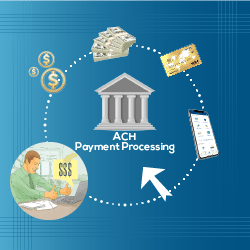
ACH, the abbreviated form of Automated Clearing House. ACH is the process of transferring money between the accounts of different banks electronically. They empower you to send or get cash advantageously and safely.
You might be utilizing ACH transfers without acknowledging it. In case you’re paid using the direct store, for instance, that is a type of ACH transfer. Paying your bills online through your financial balance is another. You can likewise utilize ACH transfers to make single or repeating stores into an individual account. An available money market fund, or a school reserve funds account. Business proprietors can likewise utilize ACH to pay sellers or get payment from customers and clients.
ACH transfers have numerous utilizations and can be more cost-effective and easy to use. Then composing checks or paying with a credit or credit card. If you want to explore more about ACH payment processing, this blog is for you!
Types Of ACH Payment Processing
The ACH payment processing is categorized into two types,
- ACH Deposit
- ACH Payment
In the ACH transactions customers, organizations, or different elements can drive cash into other banks. Regardless of whether that is between their financial accounts, between people, to pay providers. Or when businesses store finance in their employee bank account.
Direct ACH Payment
Direct Payment Work the reverse way around from direct stores. As opposed to driving cash into accounts, in these situations, people, organizations, or different elements pull cash from accounts. In case that you’ve set up repeating payments with your PSP. For example, that organization will consequently pull assets from your Bank consistently.
The Flow of ACH Payment working process;
- ACH payment initiation
- Originating Bank Collects Entry
- Originating Bank Forward Entry Batch
- Operator forwards Entries
- Receiving Bank Ensures Sufficient Funds
- Receiving Bank Debits or Credits Originating Bank
What about the Credibility of ACH payments?
ACH payment requires the trading of sensitive financial data with the end goal for them to work at all. For example, to electronically pay a person holding an account in another bank.
You should know the name of the foundation that holds their bank.
The kind of account you’re keeping their wages into, the bank’s directing number.
And your worker’s bank account number (you’ll likely need to get a voided check, as well).
Furthermore, if you have set up repeating payments with your store’s utility organization. You’ll have to give that organization similar data about your business financial account.
However, the ACH system is directed and controlled by the central government and NACHA, its own overseeing body. This association implements working principles and rules that secure this delicate and sensitive data. By which every partaking body including money related organizations, organizations, credit associations, industry suppliers, and government substances need to withstand.
To receive ACH payment for your business, ensure that your 2D payment processor is completely consistent with NACHA rules.
Let’s talk about the benefits of ACH Payment Processing.
Utilizing ACH moves to cover tabs or make individual to-individual payments offers a few preferences, beginning with comfort.
Paying your home loan, service bill, or another repeating month-to-month bill. Utilizing an electronic ACH payment might be simpler and less tedious than composing and mailing a check. Also, you can spare yourself a couple of bucks by not burning through cash on stamps. Also, an ACH payment can be safer than different types of payment.
Sending and getting ACH payments is normally brisk. As instructed by NACHA, settlement, or the transaction of assets starting with one bank then onto the next through the ACH and large happens the following day after the transaction is started.
NACHA working standards require that ACH credits settle in one to two business days. ACH charges settle the following business day.
Another advantage is that ACH payments are frequently free. Contingent upon where your bank and the kind of move are included. For instance, your bank may charge you nothing to transfer cash from your financial accounts to an alternate bank. What’s more, if it charges an expense, it might be an ostensible expense of only a couple of dollars.
What are the ACH Transfer Transaction Limits?
Numerous banks force limits on how much cash you can send utilizing an ACH transfer. There might be per-transaction limits, day by day cutoff points, and month to month or week by week restrictions. There may be one breaking point for charge installments and another for moves to different banks. Or then again one kind of ACH transaction might be boundless yet another may not. Banks can likewise force limits on where you can send cash to.
Timing Matters for ACH Payment Processing
When you decide to send an ACH transfer matters because one out of every odd bank sends them for bank handling simultaneously.
There might be a cutoff time by which you have to get your transaction in to have it handled for the following industry day. Initiating an ACH move after the cutoff could bring about a deferral, which might be an issue in case you’re attempting to hit a due date for one of your bills to stay away from late charges.
So, you learned how beneficial and convenient is using an ACH payment transfer. You can accept ACH payments instantly and enjoy secure features too. If you are interested in starting this payment method then you can contact eMerchant Pro. eMerchant Pro offers the best services for ACH Payment processing.